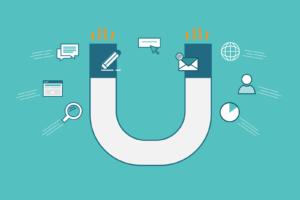
Before we delve into what an inbound marketing campaign should look like, we should briefly cover what inbound marketing is.
Inbound marketing attracts potential customers by offering relevant content, allowing them to understand and solve their problems throughout the buyer’s journey.
Inbound marketing is different from outbound marketing, which is more traditional and seeks to interrupt potential customers, rather than ensuring you are found by the people who are already searching or shopping for your product or service (see our inbound vs outbound marketing blog for further insight).
An overarching inbound marketing strategy is usually divided into separate inbound marketing campaigns. HubSpot defines inbound marketing campaigns as ‘concentrated efforts that align your marketing channels around a single message and goal’, through a promoted content offer relevant to your potential customer. But what should an inbound marketing campaign look like?
Planning an inbound marketing campaign
An inbound marketing campaign is a content-driven activity. The main goal is to attract new leads to your business by providing them with the information they want.
In order to devise a successful inbound marketing campaign, you will need to complete some key planning tasks including setting goals or KPIs, understanding the buyer persona you are targeting, and creating a content strategy.
Goals
Firstly you need to outline your goals or KPIs for this campaign, to ensure your campaigns are measurable and focused on driving results. Using SMART goals you are able to create Specific, Measurable, Attainable, Relevant, and Timely goals.
To help you create your own SMART goals, take a look at the points below, in this case for growing blog traffic:
1. Is your wording specific enough? Example: ‘We want to increase the volume of traffic to our blog by targeting two different buyer personas in four blog posts per month
2. Are your goals measurable? Example: We’re aiming for a 5% traffic increase
3. Are your goals attainable? Example: Blog traffic went up 3% last month after increasing posts published from two to three
4. Are your goals relevant? Example: By targeting our buyer personas and posting more frequently, we’ll not only generate more traffic but we’ll also be providing more relevant content to our audience
5. What is the timescale? Example: By October 2020 we will see a 5% increase in traffic
Buyer persona
You need to identify which of your buyer personas you will be targeting through your inbound marketing campaign. A buyer persona is a projection of your ideal customer, based on data about your current customers and your industry. Using buyer personas has many benefits, including making it easier to create useful content to help improve the quality of your leads, and know which to qualify.
If you haven’t yet developed your buyer personas you can learn more in our post, What is a Buyer Persona?
Content strategy
To help structure your content within your inbound marketing campaign and allow your target audience to make a well-informed decision, you will need to revert back to your content strategy in order to attract your buyer persona, by creating content at the relevant stage of the buyer’s journey in order to engage them.
If you don’t yet have a content strategy, including core topics, subtopics and monthly search volume data, then visit HubSpot’s guide on How to Develop a Content Strategy before you get started.
Setting up your inbound marketing campaign
Now you know your campaign goals, you have your content offer and you know who you’re targeting, you can set up your campaign.
A CRM such as HubSpot or Salesforce will allow you to manage your campaigns, nurture your leads and measure your campaign performance.
Here are the steps you could follow to create your campaign:
1. Create your content offer - as well as ensuring your content is relevant to your buyer persona, you can also create smart content that will allow you to deliver the right information to your audience, depending on their buyer persona and/or factors including location and behaviour. Make sure to structure your content using H1s and H2s and test your content offer and continue to optimise it.
2. Calls to action - you need to ensure your content offer has clear CTAs which link back to your goals and KPIs, e.g. ‘book a demo’ or ‘contact us’. You can also use smart CTAs to ensure relevance.
3. Landing page creation - create your landing page to capture information from potential customers. By filling in a form, your potential customer will be able to download content offers such as ebooks, whitepapers and free demos.
4. Use forms - not all content needs to be gated, however forms will allow you to collect valuable information on your visitors, and by using dynamic fields in forms you will be able to qualify them, with lead-scoring metrics such as company size. This will help align sales and marketing processes too.
5. Segmentation - as your campaign gathers more information about your leads, make sure you segment and effectively manage your contacts. You can do this by building targeted lists and lead scoring. You can also build smart content to nurture your customers through the funnel with marketing automation.
6. Automation - build emails in advance and set up workflows to trigger once a form is submitted. This helps to ensure leads are followed up, by automatically sending them more relevant content, which continues to push them through the buyer’s journey. You can also use automation to improve internal processes - for qualifying leads from your campaign, for example.
7. Campaign promotion - through your content strategy you will know where your prospects spend their time online,, enabling you to deliver your audience the right content at the right time to hit your goals. Promotion could be in the form of email marketing, paid media, or SEO to generate organic traffic. Our blog post on 17 Essential Inbound Marketing Tactics dives deeper into this.
8. Feedback - getting feedback from your customers and leads on your campaign will allow you to continue to develop your inbound marketing strategies and continue to delight your customers.
9. Report on your results - using Google Analytics or CRM reporting tools helps you accurately report on what has and hasn’t worked in your campaign, and also identify improvements.
In summary, an inbound marketing campaign needs to be planned carefully in order to hit KPIs and deliver results.
By delivering the right content at the right time, in the right place, you will be able to attract, engage and delight your prospects and customers, gather valuable lead-scoring information to pass to the sales team, and as a result, grow your business.
By reporting on your results you will gain valuable insights and key learnings that you can use to continue to optimise your campaigns.




